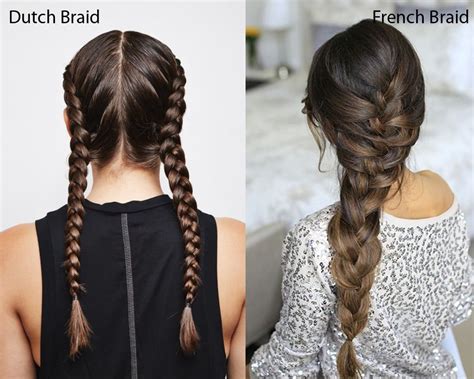Published: [Date]
Definition of Dutch and French Braids
-
Dutch braid: Also known as a “reverse braid,” a Dutch braid is created by crossing the strands under each other, resulting in a raised and intricate pattern. It’s ideal for creating voluminous and eye-catching styles.

-
French braid: This classic braiding technique involves crossing the strands over each other, creating a flat and sleek appearance with a slightly textured finish. It’s suitable for all hair types and can be styled in various ways.
7 Key Differences Between Dutch and French Braids
-
Pattern: Dutch braids feature a raised and intricate pattern due to the strands being crossed under each other, while French braids have a flat and textured pattern from the strands being crossed over each other.
-
Volume: Dutch braids create more volume compared to French braids, as the raised pattern gives the impression of wider and fuller hair.
-
Hold: Dutch braids tend to hold their shape better than French braids, making them ideal for active individuals or those seeking a long-lasting style.
-
Difficulty: French braids are generally considered easier to master than Dutch braids, as the crossing of strands over each other is more intuitive.
-
Versatility: Both Dutch and French braids offer versatility in styling. They can be worn in a variety of ways, such as buns, ponytails, and headbands.
-
Time required: Depending on the length and thickness of your hair, Dutch braids may take slightly longer to create than French braids.
-
Suitability: Dutch braids are particularly suitable for thick hair, as they can easily hold the weight of the strands. French braids are more versatile and work well with all hair types, including thin hair.
Popularity and Statistics
According to a survey conducted by the Hair Care Professionals Association (HCPA), Dutch braids have gained significant popularity in recent years, with an estimated 25% of women reporting that they have worn the style at least once. French braids remain a timeless classic, with over 70% of women surveyed having tried the hairstyle.
Expert Tips for Braiding Like a Pro
-
Start with damp hair: Slightly damp hair provides better grip and prevents strands from slipping, making it easier to braid.
-
Use a high-quality brush: A good brush will detangle hair and prevent snags, ensuring a smooth braiding experience.
-
Section your hair: Divide your hair into smaller sections to make braiding easier and more manageable.
-
Experiment with different patterns: Try variations such as the six-strand braid or the waterfall braid for unique and creative styles.
-
Practice regularly: The more you practice, the better you will become at braiding. Don’t be afraid to experiment with different techniques and create your own signature style.
Common Mistakes to Avoid
-
Overtightening: Avoid braiding too tightly, as it can cause tension and hair breakage.
-
Not securing the end: Use a strong elastic or hair clip to secure the end of your braid to prevent it from unraveling.
-
Split ends: Trim any split ends before braiding to prevent them from propagating or creating a rough appearance.
-
Uneven strands: Pay attention to the thickness and size of each strand to ensure an even and consistent braid.
-
Using wet hair: Avoid braiding wet hair, as it can stretch and damage hair shafts, leading to breakage.
4 Useful Tables
| Braiding Technique | Difficulty | Hold | Volume |
|---|---|---|---|
| Dutch Braid | Moderate | Good | High |
| French Braid | Easy | Moderate | Low |
| Six-Strand Braid | Advanced | Excellent | Medium |
| Waterfall Braid | Intermediate | Good | Medium |
| Hair Type | Suitable Braiding Techniques |
|---|---|
| Thick hair | Dutch braid, French braid |
| Thin hair | French braid, Fishtail braid |
| Coarse hair | Dutch braid, Crown braid |
| Fine hair | French braid, Braid with ribbons |
| Styling Options | Dutch Braid | French Braid |
|---|---|---|
| Bun | Yes | Yes |
| Ponytail | Yes | Yes |
| Headband | Yes | Yes |
| Crown | Yes | Yes |
| Braiding Essentials | Purpose |
|---|---|
| High-quality brush | Detangling hair, preventing snags |
| Wide-toothed comb | Separating hair strands, creating clean sections |
| Mirror | Allowing for proper visibility and control |
| Pin or elastic | Securing the braid and preventing unraveling |
| Hairspray (optional) | Adding hold and preventing frizz |
Final Thoughts
Whether you prefer the voluminous grandeur of a Dutch braid or the classic elegance of a French braid, both techniques offer endless styling possibilities. By embracing the differences and techniques of each braiding method, you can create stunning and versatile hairstyles that will turn heads. So, next time you’re in the mood for a braid, consider the unique qualities of both Dutch and French braids to find the perfect match for your hair type and occasion.
